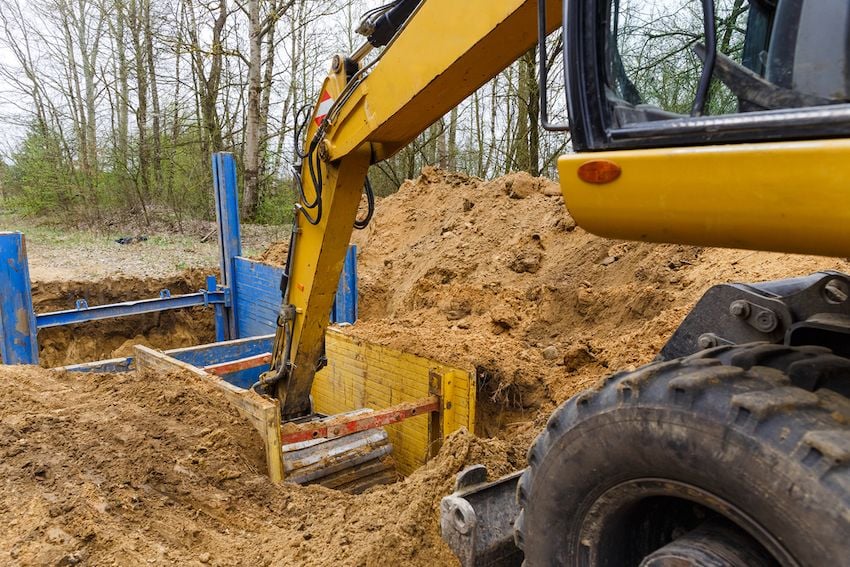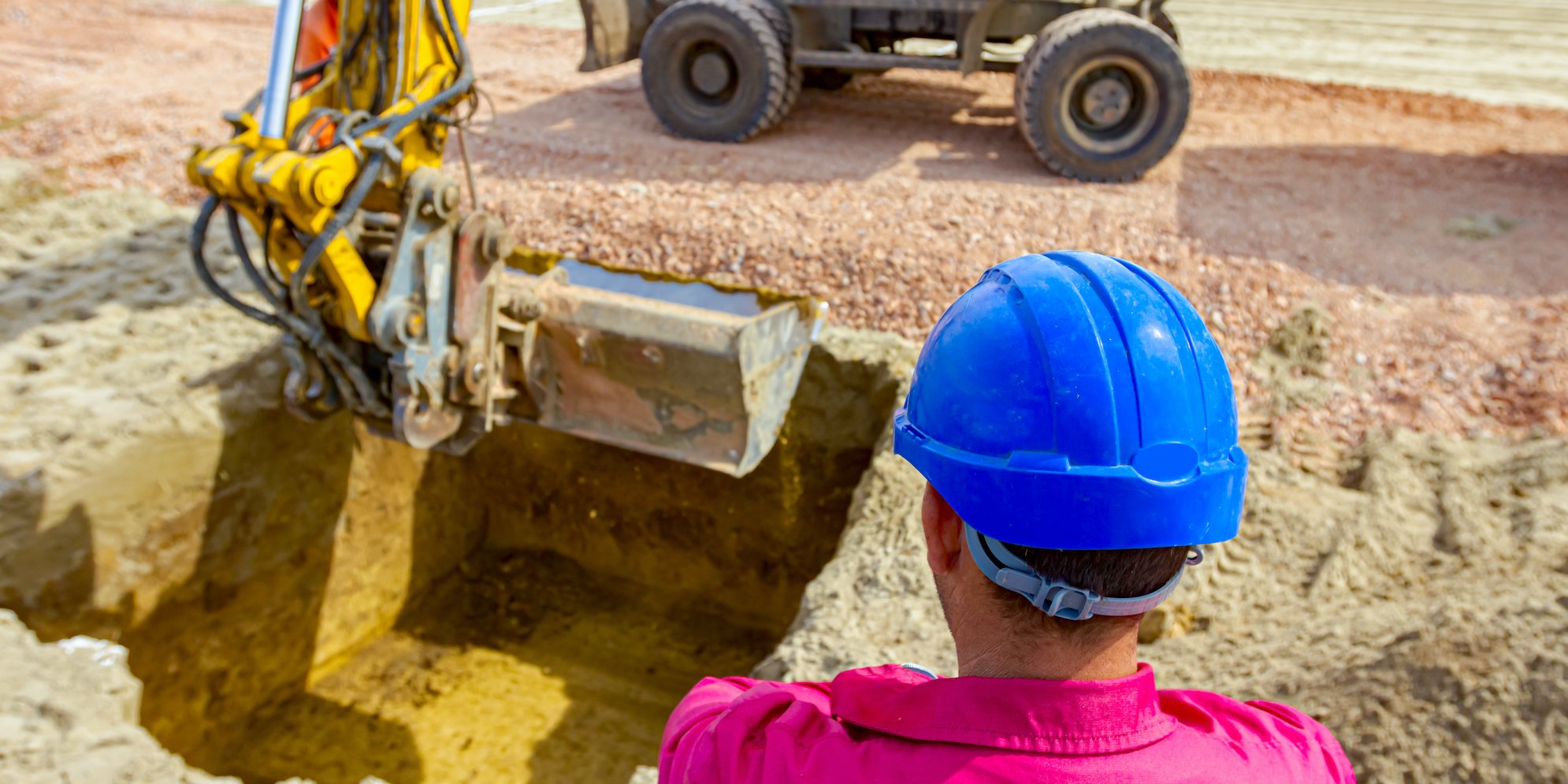Trenching and excavations are two of the most dangerous construction operations, according to the Occupational Safety and Health Administration (OSHA). And when you see just how many hazards are associated with these activities, it’s no wonder why.
Here, we discuss the most prevalent trenching and excavation hazards and precautions. Wondering what is the greatest risk with excavations? Read on to find out.
11 trenching and excavation hazards
1. Cave-ins
Cave-ins are, by far, the greatest excavation risk. Also known as trench collapse, 168 workers lost their lives in this type of accident from 2011 to 2018, according to the Bureau of Labor Statistics (BLS).
To prevent cave-ins, a competent person must evaluate the soil to determine the proper protective systems (sloping/benching, shoring, or shielding), according to OSHA. Workers must also have a safe way to enter and exit the trench, and excavated material must be placed the proper distance from the edge of the trench (both discussed more below).
Read more: How to Protect Workers From 4 Excavation Safety Hazards
2. Water-related hazards
Workers face several water risks while inside or near an excavation. Water can cause the sides of a trench to become unstable. It also poses a drowning hazard inside the trench itself. Workers may also be electrocuted if electrical equipment is present.
To prevent water-related trenching and excavation incidents, inspect trenches after a rainstorm or other water intrusion.
3. Inhalation dangers
From 2011 to 2018, there were 126 instances of workers inhaling a harmful substance in a single episode while in a confined space, according to the BLS. The most common types of inhaled gasses included hydrogen sulfide (38 cases), carbon monoxide (23 cases), methane (10 cases), and sewer gas (six cases).
Minimize the risk of inhalation injuries and illnesses by making sure all workers are outfitted with proper respiratory protection. Wearable sensors can also detect harmful odorless gasses, alerting workers with enough time to evacuate an area.
Check out: Top Environmental Health and Safety Technologies for 2022
4. Oxygen shortage
According to EHS Today, it’s not uncommon for trenches to contain toxic gasses such as nitrogen, which deplete oxygen and can cause death by asphyxiation. In fact, there were 39 cases of oxygen depletion involving workers in a confined space from 2011 to 2018, according to the BLS.
Accidents of this nature can largely be prevented by taking actions like using fixed oxygen-deficiency and toxic-gas monitoring systems and ensuring workers are outfitted with the proper personal protective equipment (PPE).
5. Underground utility strikes
Underground utility lines (gas pipelines, electric lines, water and sewer pipelines, etc.) are plentiful. Accidentally striking a line can lead to serious incidents like natural gas leaks and electrocutions.
Fires and explosions caused 58 worker deaths—46 of which were explosions—in confined spaces from 2011 to 2018, according to the BLS. During the same time period, five workers died from direct exposure to electricity (220 volts or less) in a crawl space.
It’s the law to contact 811 in order for utility lines to be located prior to any excavation work. Skipping this important step can lead to worker safety incidents.
Look: 6 Safety Protocols Workers Commonly Neglect
6. Equipment problems
Tools are supposed to make excavations easier, but that isn’t always the case. Both inside and around the excavation, equipment issues can cause serious injuries.
For example, equipment can fall into the trench when barriers aren’t used, according to OSHA. Improperly functioning equipment can also cause inhalation risks—i.e., carbon monoxide—and heavy machinery can cause cave-ins.
7. Excavation spoils
Excavated material, called spoils, is an excavation hazard. Spoils add weight to the ground near a trench, which can cause a cave-in. Spoils can also fall into a trench.
To ensure trench safety, OSHA says to keep spoils and other materials at least 2 feet from the edge of a trench. Under certain conditions, spoil piles may need to be located even further away.
8. Falls
You may not associate falls with construction work happening on the ground, but workers have lost their lives after falling into a trench. Falls to a lower level of a confined space are a major cause of workplace fatalities, according to the BLS. From 2011 to 2018, 156 workers lost their lives in a fatal fall. One of the most common coded confined space falls occurred in ditches, channels, trenches, and excavations—totaling 15.
To promote excavation safety at worksites, OSHA recommends placing a barrier around the excavation, hanging brightly colored or reflective tape in low light conditions, ensuring signs alerting the location of the excavation are properly posted, and requiring fall protection at six feet.
9. Egress
Proper egress is a huge part of trench safety because workers must have the ability to get out of a trench quickly in case of emergency. Employers must provide ladders, steps, ramps, or other safe means of egress within 25 feet of workers in trench excavations of 4 feet or deeper, according to OSHA. The means of entry and exit must be within the cave-in protection system.
Related: 6 Safety Stand Down Topics for Pipeline Construction Workers
10. Ergonomic issues
Working in a confined space for a long period of time can be hard on the body. Activities like working in awkward postures, exerting excessive force, and repetitive motions often lead to ergonomic issues such as lower back pain, neck and shoulder injuries, and carpal tunnel syndrome.
OSHA recommends several ways to combat this, including regularly reviewing injury records, monitoring working conditions for risk factors, and encouraging workers to report injuries as soon as they happen.
11. Extreme temperatures
Working outside means your team has to contend with Mother Nature. Both heat-related injuries and cold stress can be an issue with excavations.
In fact, five workers died from exposure to environmental heat in a crawl space from 2011 to 2018. Even if temperatures above ground are manageable, OSHA notes that trenches might be hotter than surrounding areas because air movement is blocked.
To avoid heat-related illness, OSHA recommends taking both environmental health and metabolic heat into account to calculate workers’ total heat stress. This should then be compared to published occupational heat guidance to determine if working conditions are safe.
As for cold stress, common illnesses and injuries caused by these conditions include hypothermia, frostbite, and trench foot. OSHA advises training workers to recognize the signs of cold stress, providing engineering controls, using safe work practices, and ensuring workers dress properly to safeguard against this hazard.
Although trenching and excavations are dangerous, it is possible to work safely. Continuously train workers on excavation hazards, follow OSHA guidelines, and stay alert for environmental changes to minimize the risk of serious injuries and worker fatalities.
Up next: Health and Safety Leaders Roundtable

